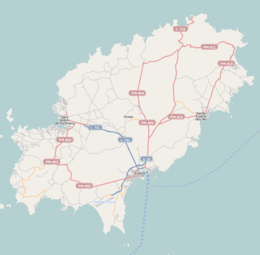Jesús (Ibiza)
Nostra Senyora de Jesús is a village on the northern side of Ibiza Bay,[1] On the Spanish island of Ibiza, Spain. The village is in the municipality of Santa Eulària des Riu and is located on the designated road PMV 810.[2] The village is 2.0 miles (3.2 km) North of Ibiza Town and 6.7 miles (10.8 km) of Ibiza Airport.
Nostra Senyora de Jesús | |
|---|---|
Village | |
 The Parish Church | |
 Nostra Senyora de Jesús Location of the village in Ibiza | |
| Coordinates: 38°55′51″N 1°26′58″E | |
| Country | |
| Region | Balearic Islands |
| Population (2006) | |
| • Total | 4,499 |
| Time zone | UTC+1 (CET) |
| • Summer (DST) | UTC+2 (CEST) |
Description
The village of Jesús is short distance along the road to Cala Llonga from Ibiza town. No longer a village but more of a suburb[3] of the Ibiza town these days. The village offers a wide range of restaurants and small shops. There are also several beaches in the vicinity of the village, such as Platja S'Estanyol and Talamanca.
The Can Pep Simó Estate
On the hillside above the village are two important housing developments. The Can Pep Simó estate, designed in the 1970s by Catalan architect’s of Erwin Broner and Josep Lluís Sert. The developments are described as a combination of traditional and modern architecture and attracts students of architecture from across the globe.
The Church of Nostra Mare de Jesús
At the heart of this overspill is the white washed parish church of Nostra Mare de Jesús is considered to be the oldest church on the island. Despite the ever expanding sprawl of Ibiza town, there is still an open vista of green fields and orchards towards the prominent hill of Dalt Vila of Ibiza town. It is thought that Franciscan friars established the site in 1498.[4] the Franciscan left the site after fifty years leaving it to the Dominican order, who also left the site for the protection of the Dalt Vila following raids by pirates. It was in 1755[4] that the old monastic building was turned into a parish church. What set this church above all others on the island is its Altarpiece painted around 1500 by Rodrigo de Osona.[4] The altarpiece has 25 painted panels, with the central panel having a representation of the Virgin and child. The surrounded panel have images of Saints and have themes such as the Annunciation, Jesus Nativity, Resurrection, the Ascension.
References
- Mapa Topografico Nacional de Espana, 798 Eivissa. 1:50.000. Published: IGN - CNIG (Spain Civilian Survey): 2006.
- "579 Regional Map, Spain, Islas Baleares. Pub:Michelin Editions des Voyages, 2004, ISBN 2-06-710098-X
- The Rough Guide to Ibiza & Formentera. Pub:Rough Guides, Penguin Group, 2003, ISBN 1-84353-063-5
- Ibiza & Formentera’s Heritage, A Non-clubber’s Guide. Author: Paul R Davis Pub:Barbary Press, 2009, ISBN 978-84-612-2908-6